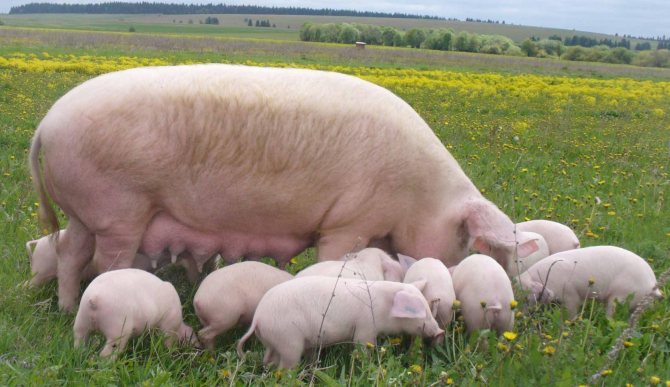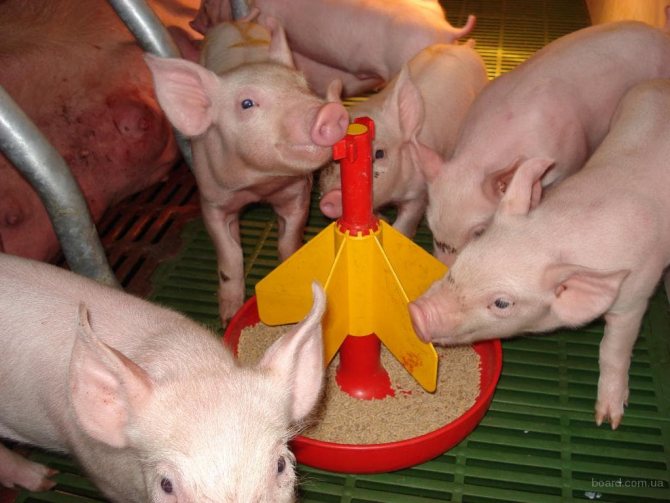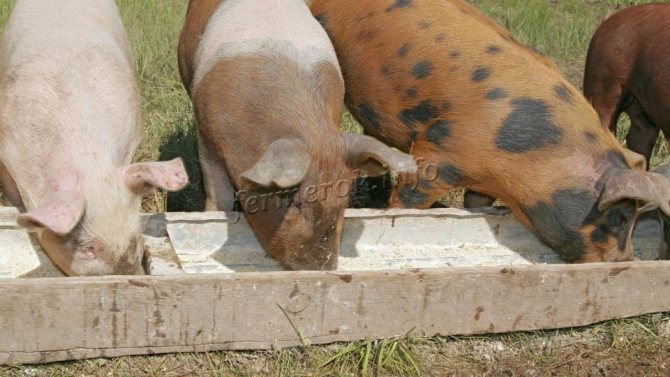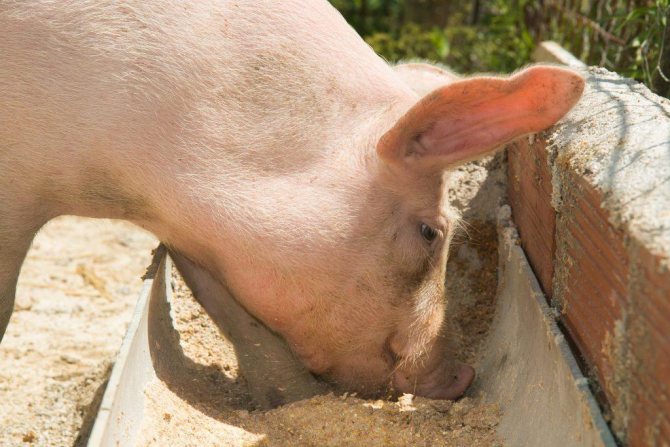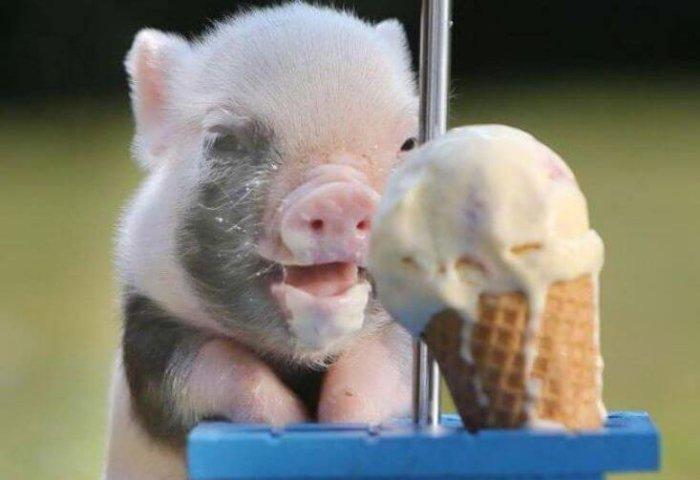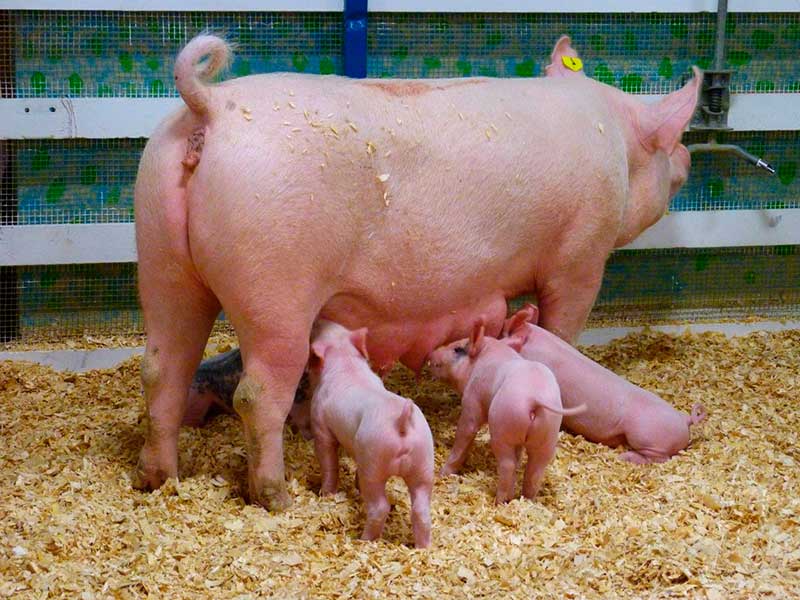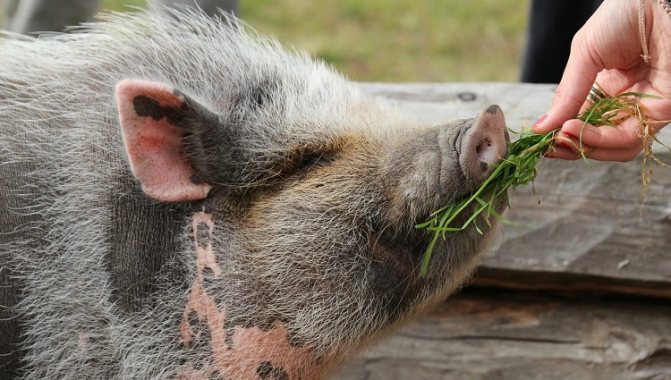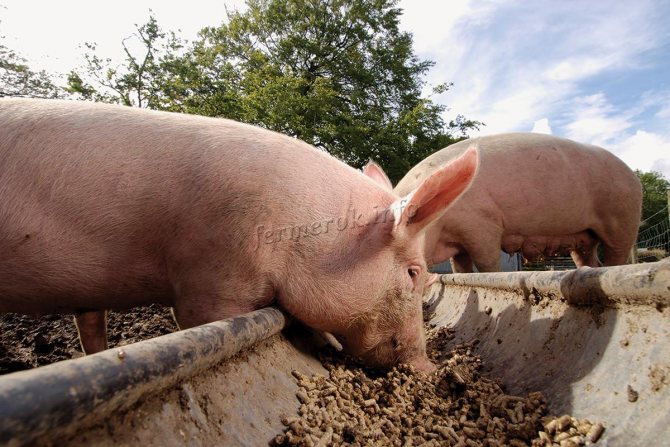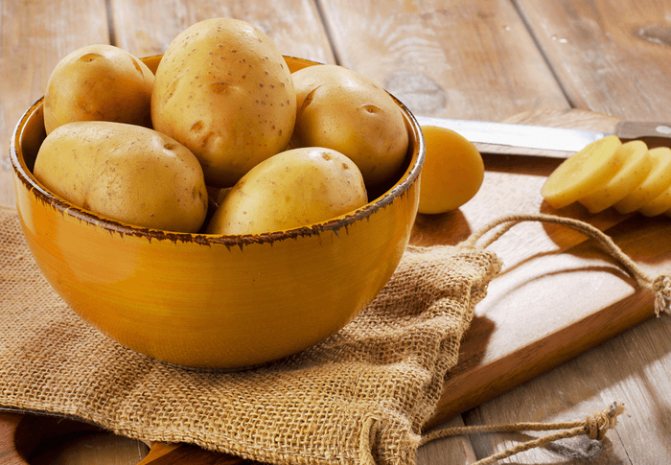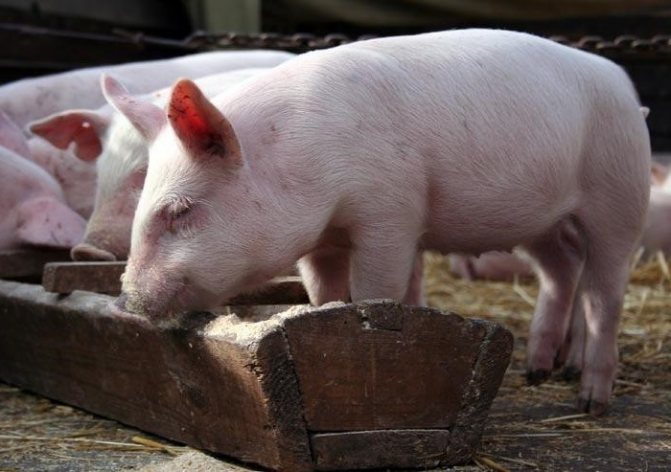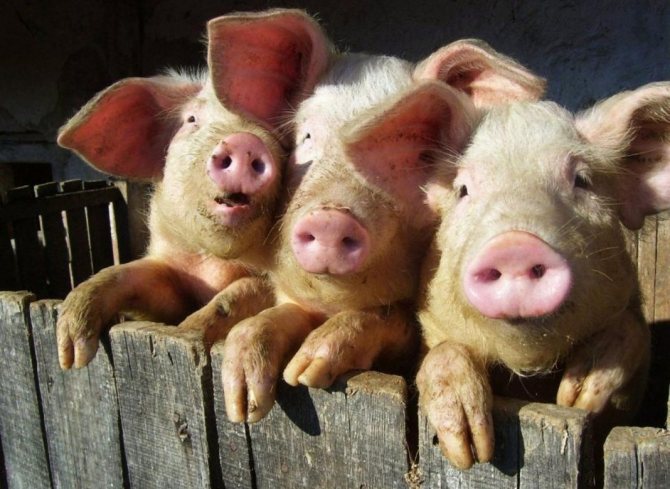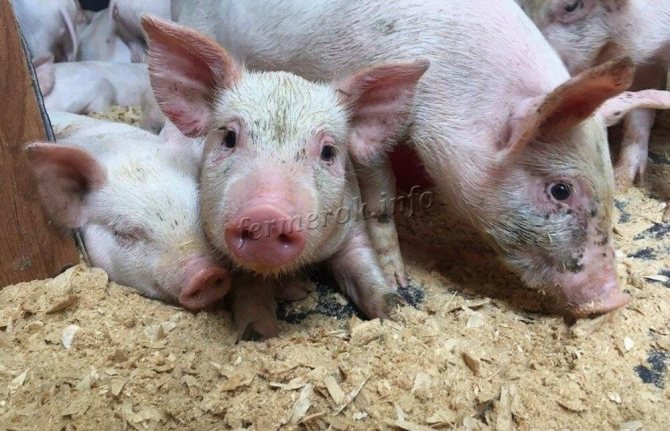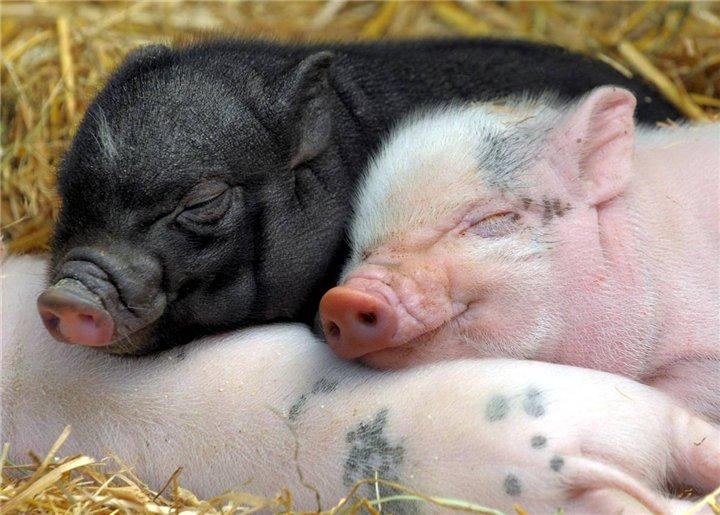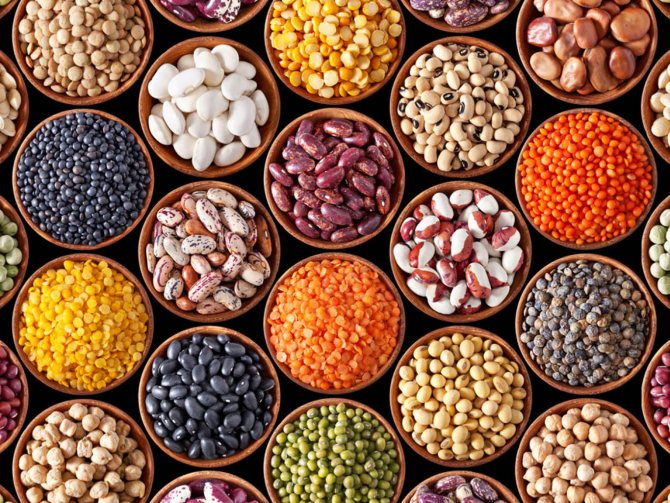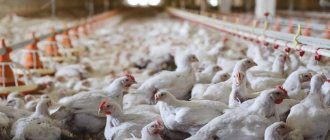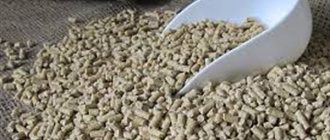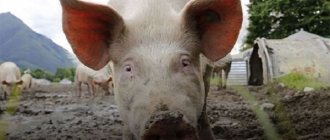If you decide to have a pig, you must always remember that feeding young pigs, like any other domestic animal, seriously affects the health, growth and development of the wards. The pig's body is not a bucket for food waste, so you need to carefully approach the feeding ration, norms, diet, on which, as a result, the quality of the final product depends, on which long painstaking work was carried out.
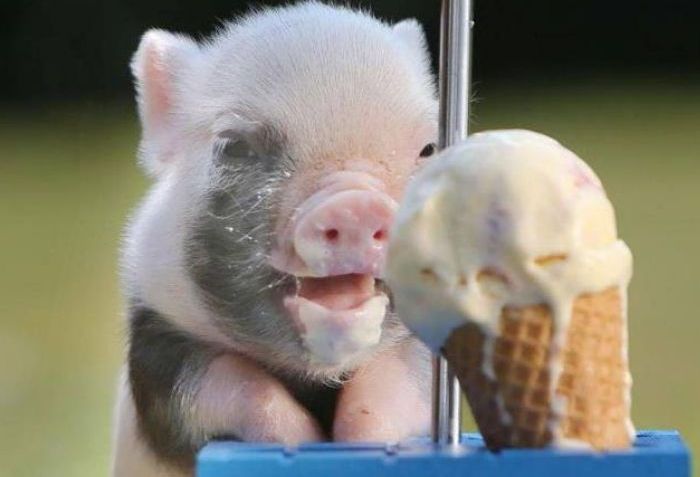
Feeding piglets
Feed classification
Forages are products that are used to feed animals, they are rich in nutrients and are the nutritional basis for rapid weight gain. There is a specially developed classification of feed, which allows you to assign a particular product to a specific type.
Vegetable feed
Plant-based foods form the basis of the pig's diet, so let's consider a small classification of such food.
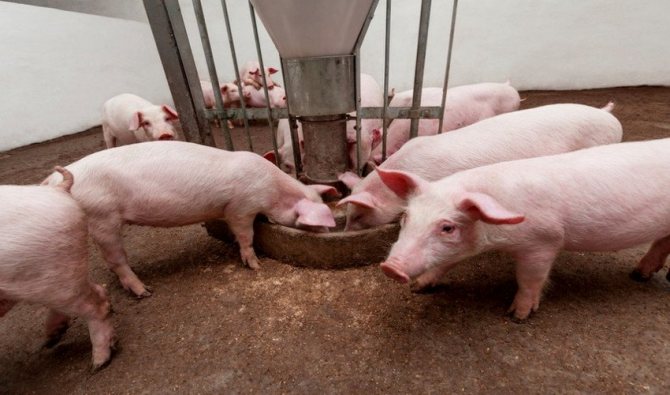

Cereals
Cereal fodder is necessary for increasing the mass of animals, therefore it must be present in the diet. Cereals contain a large amount of carbohydrates, plant proteins, and coarse fiber.
Cereals used for feeding are represented by:
- Barley - the best cereal for a pig, which is absorbed by the body by 90%. Barley should make up 70% of all cereals on the menu, since they can be fed to individuals of any age.
- Corn - takes a small percentage in the composition of the pig's cereal menu, since it contains a small amount of proteins that are responsible for the quality of meat.
- Oats - has the maximum fiber content, therefore it is necessarily included in the menu of young animals, suckers and suckling queens.
- Peas - added to the diet steamed, saturates the body with vegetable protein and significantly improves the quality of animal meat.
- Wheat - a popular feed for pigs, almost on a par with barley, it contains a large amount of nutrients, causes a quick saturation of the body and gives a large supply of energy.
- Rye - gives good results in use for growing and fattening, leading among other cereals.
- Millet - takes 15% in the composition of grain mixtures for pigs, its composition is similar to corn.
It will also be helpful for you to learn how to make your own pig feeder.
Juicy feed
Vegetables and root crops are combined into a group of green feeds, they are usually given in grated form, mixed with crushed grain. The amount of succulent feed fed is usually increased during the absence of green feed.
Juicy feeds that are regularly given to pigs include:
- Potatoes - the main root vegetable in the pig's diet (up to 30% of the total food volume on the menu), it is usually given in boiled form: this way it is better digested.
- Carrot - healthy food, improves the taste of animal meat. It is often used for feeding sows and suckers to saturate the body with vitamins.
- Beetroot - give both fodder and sugar appearance. The second, more nutritious, can be given along with the tops. Usually, it is boiled before serving so that it is better absorbed.
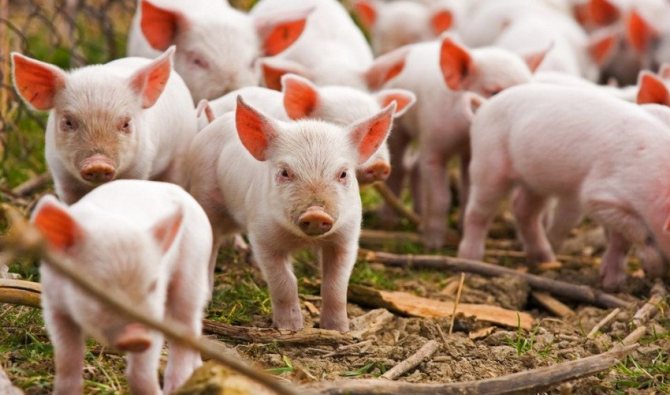

Green feed
Green feed is used to feed pigs to saturate their bodies with proteins and nutrients. Green forages are seasonal, but can also be dried and used like hay, with little loss of nutrients.
The greens used for feeding pigs are presented in the form of:
- beet leaves;
- peas;
- clover;
- dandelion;
- young swan;
- alfalfa;
- wood lice;
- nettles.
Combined silo
Plant-based silage is the most nutritious food for pigs. The uniqueness and economy of the finished product lies in the fact that it can be prepared by combining different products that can be found in any household.
Find out what types there are, and how to prepare compound feed for pigs with your own hands.
The composition of the combisilos can be presented:
- potatoes, clover grass, carrots with tops, cabbage leaves (in a ratio of 4: 3: 1.5: 1.5);
- carrots, fodder beets, green legumes, hay flour (in a ratio of 2: 5: 2: 1);
- corn cobs, pumpkin, green beans (in a ratio of 6: 3: 1).
It is better to harvest vegetables and root crops raw, and boil potatoes.
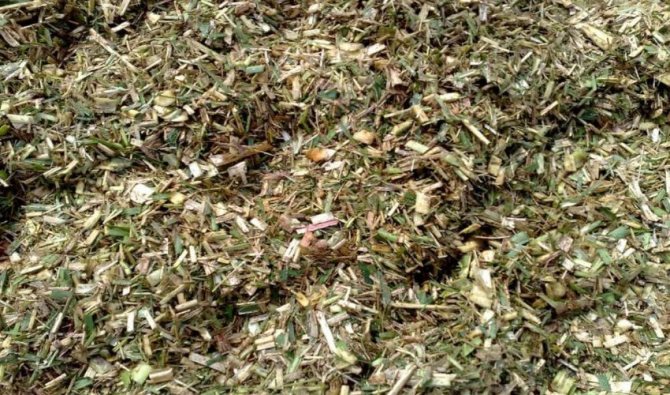

Animal feed
Pigs can eat any food, so they are often offered the waste that remains after human consumption. Useful waste includes fish and meat, with a large amount of protein and minerals. Before serving the waste, they are well boiled and grinded so that the pig can chew them normally and not get hurt.
Important! It is noticed that after eating meat and fish waste, pig meat smells unpleasant, therefore, 2 months before slaughter, they are excluded from the menu.
Dairy products (whey, milk, buttermilk, return) have a positive effect on the quality characteristics of meat and lard, therefore they are given not only to suckers, but also to fatteners. Animals are happy to eat this kind of food.
What are premixes for?
In order to quickly fatten the pig, the diet is enriched with food additives. They begin to feed from a young age (in the second week of life). Thanks to premixes, the weight of a piglet can increase by 4 times in 2 months.
In addition to the rapid growth and weight gain of pigs, premixes can improve the taste of meat, have a positive effect on the immunity of animals. Since pigs gain weight faster than usual, this saves on food by reducing the time it takes to grow.


Composition of feed additives
Depending on the age and special periods of pigs' life, the percentage of the components of feed additives differs, but the list of useful components remains unchanged.
Feed additives are rich in:
- phosphorus;
- magnesium;
- sodium;
- lysine;
- threonine;
- manganese;
- iron;
- cobalt;
- copper;
- zinc;
- selenium;
- vitamins A, D3, E, B6, B12;
- nicotinic acid;
- pantothenic acid.
Number of additives
The amount of additives used is influenced by which group the animal belongs to. Always on the package with supplements contains the necessary information about the norms of feeding. For example, pigs weighing more than 60 kg should consume 1% of the supplement per day, based on the total weight of the diet per day.
For pregnant and lactating sows, 3% of the supplements are prepared, and the piglets (10-60 kg of body weight) are given 2.5%.
Pig feeding options
So, the farmer has acquired an adult pig or piglet, and now he needs to choose the appropriate feeding regime, while it is important to avoid such dangers as overfeeding, excessive food consumption or health problems. In some cases, there is a chance to see how the pig that has eaten stops breathing, and all because of inappropriate food.
Both in industrial and domestic conditions, feeding is carried out in one of 3 main directions. Some breeds are bred for one type of feeding, while others are a kind of generalists:
- Fattening piglets for meat. Piglets are used here, which, depending on the variety, are sent to slaughter at the age of 6-8 months.They quickly gain weight and clog when they reach 110 kg. This is a classic figure that experienced miners are always guided by. Slaughtering smaller piglets is not profitable, so people with experience do not try to do this.
- Bacon feeding. Here, the product is already more fatty, and there are always layers of fat in the meat. Growing here takes place under different conditions than when obtaining lean meat. Piglets selected for bacon fattening should weigh 25-27 kg at the age of 85-95 days. There are special breeds that are best suited for this type of cultivation.
- The last type is the so-called fattening. In Ukraine, such a fattening is called easier and more understandable - lard. They use meat-sucking pigs or adult animals that have been rejected for one reason or another. Fattening is also carried out according to certain rules, in violation of which both meat and lard (or lard) are of poor quality and are not suitable for consumption.
It should be borne in mind that meat and bacon are more in demand on the market than lard, therefore it is on them that pigs are usually fed. And in terms of costs, bacon and meat methods are cheaper than fattening. But the cultivation of pigs for lard also should not be discounted, because tasty and high-quality lard is also selling well. Ultimately it all depends on the available feed, breed and other individual factors. To a large extent, the preferences of the farmer himself also influence.
Feeding types
There are several types of animal feeding that can be successfully used on the farm, so we will consider each type in more detail.
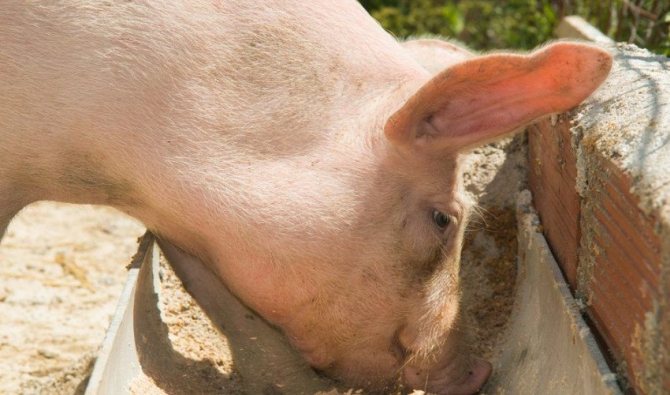

Dry feeding pigs
For the organization of dry feeding, granulated compound feed is used, which, in addition to a number of advantages, also have serious disadvantages.
- The advantages of dry feeding include:
- better assimilation of nutrients by the body;
- high safety in terms of sanitary and hygienic characteristics;
- convenience and ease of use;
- saving time for catering.
Among the disadvantages are:
- Minuses
- high cost of raw materials;
- digestive problems in animals;
- the presence of a large amount of dust from compound feed, which negatively affects the health of animals and staff serving the pigsty;
- strong scattering of such feed by pigs.
Did you know? Dry feeding is the most popular type and is used in 70% of all pig farms in the world.
Liquid feeding
Liquid type of feeding allows you to use any food, which significantly saves money.


- In addition, liquid feeding has a number of advantages:
- the possibility of abandoning drinkers;
- the ability to accurately dose food;
- minimum spreading of feed;
- the best weight gain by animals.
- The disadvantages of liquid feeding include:
- minimum shelf life;
- exceeding the norms of humidity in the room due to constant vapors;
- the need to use expensive metal feeders.
Usually, at home keeping, a combined type of food is used, which consists of both dry and liquid feed, which is much more profitable than feeding animals only purchased dry compound feed or organizing liquid feeding, which takes a lot of time.
Nutrient Requirements for Piglets
Nutritional requirements for piglets on 88% dry matter, DLG, 2008


*) dietetic food for feeding pigs in case of diarrhea (for a limited time)
**) lysine: meth + cis: threonine: tryptophan = 1: 0.53: 0.63: 0.18
***) intestinal digestibility 90%
****) using phytase
It is necessary to feed piglets so that they receive a sufficient amount of macro- and microelements, as well as vitamins.
The requirements of piglets for macro- and micronutrients are presented here.
See piglets' vitamin requirements here.
During weaning, piglets continue to be fed with a prestarter, and then gradually transferred to compound feed after weaning or to compound feed for growing І.
Feed preparation
Before feeding the animals, depending on the species, they should be pretreated.
Preparing vegetables
Before feeding the pigs with vegetables, they are pre-washed well under running water, chopped with a knife or using a grater. It is better to steam or boil beets and potatoes, if desired, you can do the same with other vegetables.
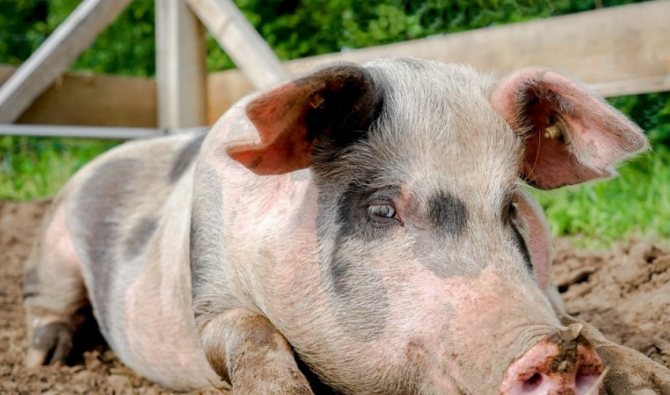

Preparing hay and dust
To improve the digestive process, hay and hay dust are recommended to be steamed beforehand, for this they are poured with boiling water for 1-2 hours. To make it easier for animals to consume long particles of hay, they are crushed.
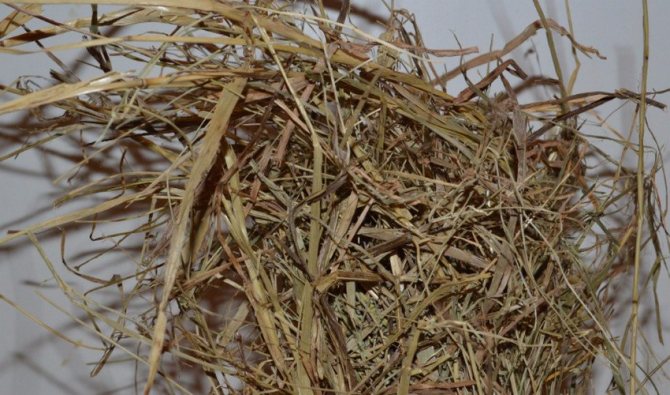

Preparation of cereals
Cereals must be grinded, achieving the finest grind. All cereals can be grinded in advance, except for corn and oats - after such processing, they quickly oxidize and begin to taste bitter. Peas are boiled before feeding for better assimilation and digestion.
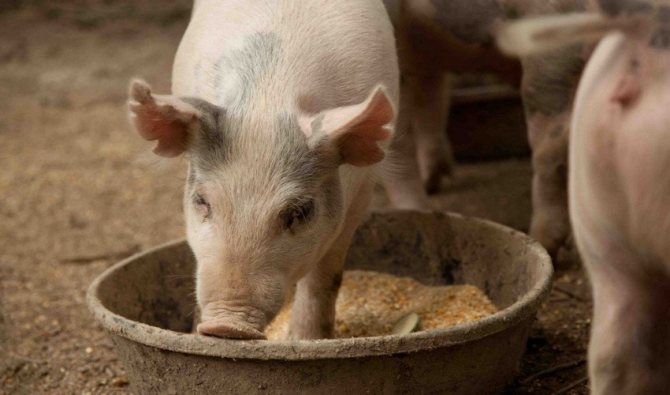

Preparation of fresh green feed
Fresh green food is well chopped before feeding so that the coarse stems are normally digested by the animals. Harvesting of grass is not carried out, it is always given freshly picked, in order to exclude the possibility of getting rotten or wilted parts.
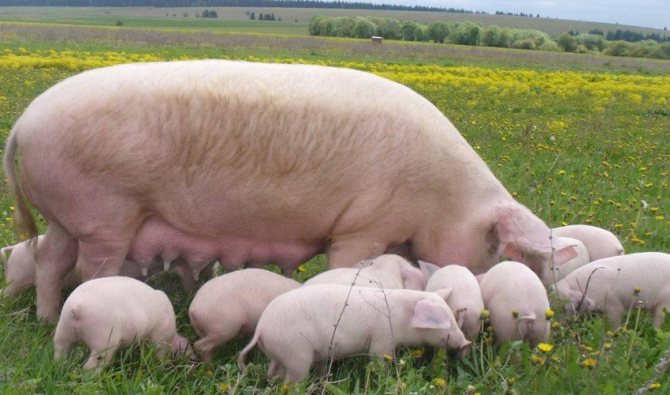

Mixed silage preparation
The composition of the silo was discussed earlier, so we will discuss the nuances of preparing this food product:
- root crops and vegetables are ensiled after full ripening, corn - during milky-wax maturity, pea greens - before flowering;
- root crops and vegetables are thoroughly washed before ensiling;
- the crushed components are well tamped into plastic bags to displace the air, this will extend the shelf life of perishable products;
- nettle and root vegetable tops cannot be used for ensiling.
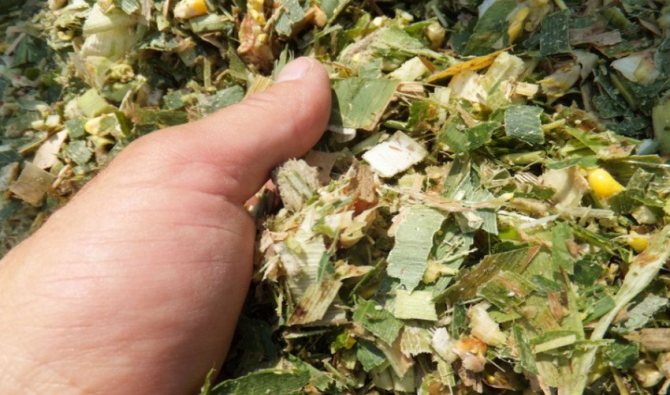

Yeast feed
To enrich the feed mass with vitamins and minerals, the yeast method is used. The procedure is performed using common baker's yeast. Such food should be 1/3 of the daily value of the concentrated feed. Such food can increase the appetite and the rate of weight gain in animals.
Consider 2 yeast methods:
- Unpaired - For 20 liters of warm (+ 40 ° C) water, use 100 g of yeast. Finely chopped feed in the amount of 10 kg is poured into the resulting solution. Insist food for 8 hours, stirring every 30 minutes.
- Starter - dough is prepared in advance. For this, 100 g of yeast and 2 kg of feed are used for 5 liters of warm water. Insist 5 hours, then add 15 liters of warm water and 7 kg of feed, stand for another 2 hours.


Feeding piglets under six months of age
The best food for growing piglets up to one month of age is mother's milk. But even newly born babies need not only milk, but also vitamins, as well as premixes for accelerated growth. Usually, in order to feed the suckers, the uterus is enough, the person only needs to add vitamins. The starter complex of premixes and vitamins is usually supplied in granules. Difficulties begin when the uterus refuses to breastfeed the piglets and no longer gives milk.
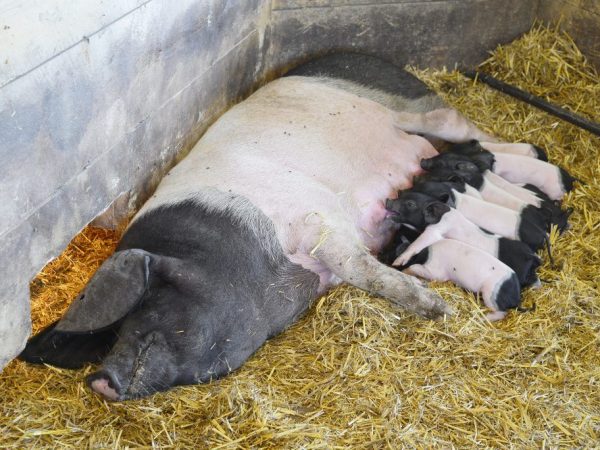

Feeding piglets
Even if the sow has not refused to feed the babies, milk alone will not be enough for them. Here you need to know how piglets are fed at home. Newborn pigs are fed with premixes for suckling pigs from the third day. It is necessary to accustom every little sucker to them as early as possible, so that they independently take these feedings. On the fifth day, you can drink them with cow's milk, and after a week you can feed the kids with various cereals.
Some farmers feed little pigs with jelly made from oatmeal. It is also given one week after giving birth. It is needed so that babies quickly gain weight, although they need liquid food most of all, already on day 10 they can be fed with soft hay, for example, tops of peas or beans. Proper feeding of growing piglets also includes a certain amount of succulent feed. But extruded feed will suit them only of the highest quality and only from one month of age.
Piglet Feeding Tips
First, it is important to know what is the best way to feed small pigs. Moreover, the recommendations are the same for breastfed gilts, and for those who are transferred to artificial feeding. Weaners are usually fed with milk replacer - whole milk substitutes. In order to artificially raise piglets, it is necessary to accustom them to the fact that feeding is carried out by humans, so the farmer will have to feed them with milk every day with his own hands. Such care will accustom kids to the owner from an early age.
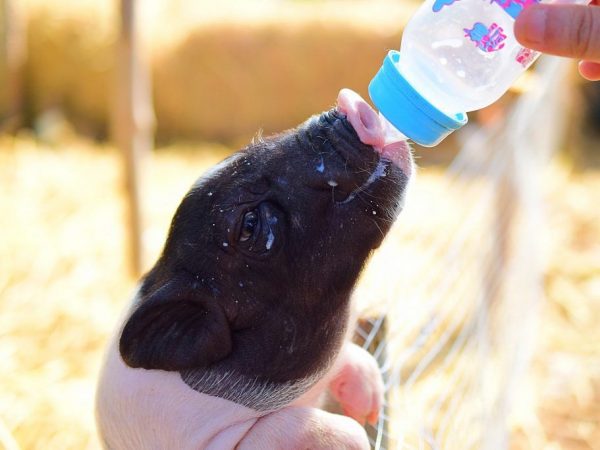

Feeding a piglet with milk
What should not feed pigs in the first month of life? Sunflower seeds, onions, fish, bread, pumpkin and other similar foods. Nothing other than milk should be given from animal feed. By the way, adult pigs are fed with fish, bone meal and other similar products in small quantities, therefore, in order to avoid problems with nutrition, it is better for novice livestock breeders to use ready-made feed from reliable manufacturers. But you need to make sure that the cost of food does not become high.
You should always make sure that little ones do not eat from the same trough with adult pigs. As already mentioned, those types of feed that will go for adult boars are not suitable for piglets. For example, acorns are good food for fattening meat, but babies are not always able to digest them. Some animals are able to eat almost any food, while others turn out to be very capricious and demanding on food, so this issue needs to be approached individually.
It is important not only what the guinea pigs eat, but also the feeding schedule.
Piglet feeding regime
If we talk about the regime, then a healthy pig eats 6-7 times a day, because it has a small stomach. It is not at all difficult to teach an animal to eat right. It often happens that the baby lies sluggish or, on the contrary, shakes, as in a fever. The problem may be illness, worms, or poisoning.
Often, the problem can be prevented simply by using the correct feeding regime, because a common cause of poor health is banal overfeeding.


Piglet feeding regime
Everyone wants to quickly fatten pigs in order to send them to slaughter early. But if you give them large amounts of food at a time, it will only get worse. It happens, of course, that some piglets calmly overpower portions, while others immediately feel bad. But it is better to give portions based on weaker babies. It is also worth feeding the kids with salty food or giving salt separately to improve digestion.
What should not be given to the animal
The food fed to pigs must be of high quality, without mold, parasites, fungus.
When using green forage, you need to pay attention to their composition.
Be sure to exclude from the diet:
- spurge;
- black nightshade;
- horse dill;
- pitted apricots;
- buttercup acrid.
The above products are poisonous and life-threatening for animals.
Important! You can not give pigs green potatoes and one that is covered with sprouts. Before feeding, the sprouts must be removed.
What can not be fed?


Prohibited foods include:
- Waste covered with mold, fungi, other parasitic organisms. Such food must be destroyed.
- Raw potatoes due to toxins and poor digestion.Especially dangerous are tubers that are green or with sprouts due to solanine, which does not disintegrate even during cooking.
- The water in which the potatoes were boiled is not suitable for making mash - it is poured out.
- A large amount of salt is contraindicated: death can occur from an overdose. Salt or salted herring is especially dangerous for piglets.
- When buying chalk, clarify the purpose of the product. Produced for drawing on a school board is not suitable because of harmful impurities that can harm the animal. Only feed types of the product are required.
- Some herbs contain toxic substances. These include euphorbia, black nightshade (basnik), dog parsley, hemlock (poisonous milestone), caustic buttercup (night blindness), water omelet, pickleberry.
- Poisoning can occur from boiled beets if they are in hot water for a long time.
Attention! The products of processing of castor oil and cotton contain gossypol - a dangerous alkaloid. Before feeding these herbs to animals, they must be treated with high temperatures or alkali.
As much food is put into the feeder as the pet can eat. The remains are thrown away so that poisoning with sour products does not happen.
It is not easy to fatten a pig at home, but it is possible. However, before deciding on a venture, it is worth calculating the potential costs and trying to optimize them. Only then will cultivation bring both pleasure from the process and benefit from the raw materials sold.
Diet and feeding rates
The age and special periods of pigs' life play an important role in the organization of feeding, therefore, we will consider the feeding norms for each group of animals.
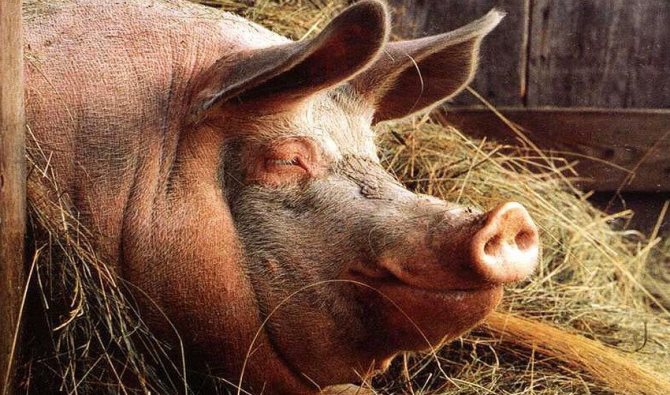

Pig feeding rules
To avoid problems in the process of feeding pigs, it is necessary to follow some recommendations:
- The feeding regimen must be followed, i.e. food is offered daily at the same time.
- The feeder is cleaned of food debris before each feeding, and it is washed once a day.
- The diet should be balanced, which is achieved by feed additives.
- Only high quality and clean feed is used.
- It is better to give all components of the feed chopped up.
- Since pigs are very fond of digging the ground, when free grazing, make sure that such an activity is safe.
The tables of feeding rates show the approximate daily ration for 1 individual, depending on age and weight.
Factors affecting the daily feed intake of pigs
The amount of food consumed by pigs may depend on:
- season of the year;
- the age of the animal;
- floor;
- health conditions;
- weather conditions.
Feeding rates for suckling pigs
It is necessary to start accustoming suckers to solid food a week after birth. At this time, they are given grains of corn or barley, pre-fried. To facilitate the process of digestion of food, any acidophilic fermented milk product is added to the menu.
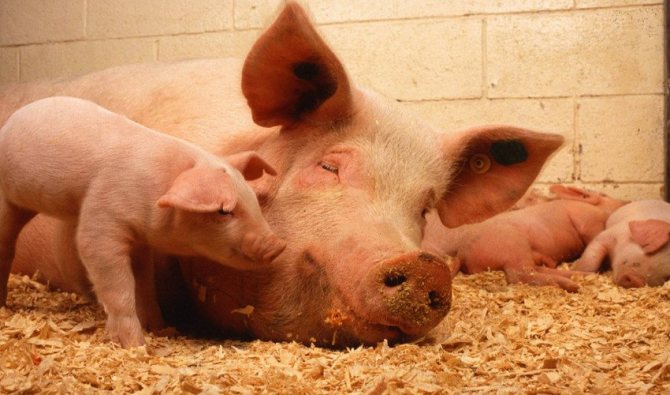

Succulent feed is given to piglets on the 10th day of life, starting with grated carrots. Boiled potatoes are introduced on the 20th day of life.
When the pigs reach 1.5 months, they are taken away from the lactating female.
At this time, meals should be three times a day, in the following ratio:
- 80% concentrates;
- 10% of vegetables and root crops;
- 5% bean flour;
- 5% meat and bone meal.
Did you know? In Canada, she created a robotic sow that feeds piglets. Milk is delivered strictly on schedule, and the robot can keep babies warm and even makes grunting sounds.
Feeding rates for rearing pigs
When animals reach a weight of 20 kg, the composition of their diet is changed. To enhance the growth of muscle mass, chopped herbs, roots and vegetables are added to the concentrates. In summer, a large amount of greens is added to the menu, mixed with boiled potatoes and grains.
Feeding rates for adult pigs
When the animals reach 40-50 kg in weight, the composition of the diet is changed so that the weight gain is faster. Every day the fattener should add 650 g.When the pig is 6 months old, its weight should be at least 100 kg.
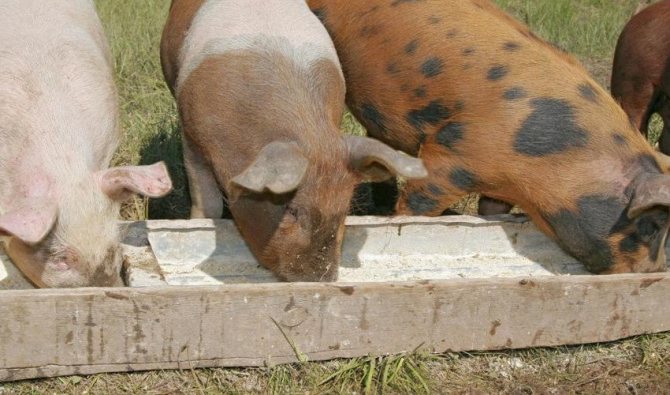

In order to maximize weight gain, the animal is given dry food, which is characterized by high nutritional value and a minimum amount of fiber.
Feeding rates for sows
For the first 3 months, the diet of the sow is the same as usual. A month before giving birth, the availability of energetically valuable feed increases by 20%. Young sows (up to 2 years old) should be fed a diet rich in vitamins and minerals.
Lactating sows are offered the most nutritious food that will allow them to feed piglets with milk. Immediately after farrowing, the sows are not given food, only water is offered. After 5 hours, the pig is offered 700 g of liquid concentrate.
The increase in the amount of food fed should be done gradually so that the sow does not get sick. After a week, the amount of food fed should reach the usual rate.
Feeding rates for breeding boars
The degree of sexual activity and the efficiency of the performance of boars directly depend on the volume and quality of the food consumed. Depletion or obesity should not be allowed, which negatively affect the above indicators.
In boars-producers, metabolic processes in the body are significantly accelerated, therefore, such animals are provided with a large amount of nutritious food. When boars rest from mating, the amount of food fed is reduced by 20%. The basis of the diet for boars is grain, cake, meal, meat and fish waste, peas.
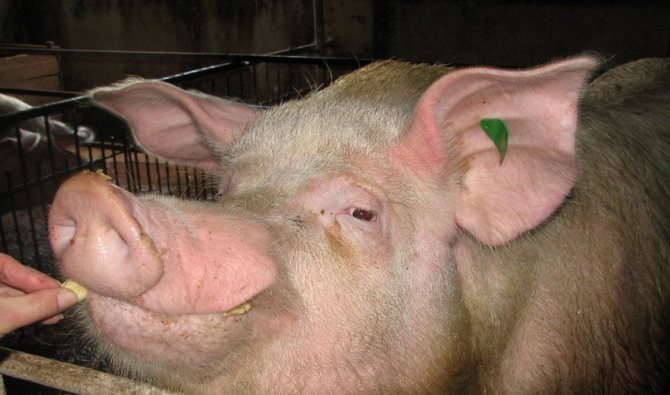

Piglet physiology influencing feeding
- Birth weight: The weight of piglets with which they are born primarily depends on the size of the nest and the correct feeding of the sow during pregnancy. It is possible to increase the weight of newborn piglets only relatively, thanks to proper feeding. The birth weight of a piglet greatly affects its development and productivity in fattening.
- Colostrum: timely and sufficient receipt of immune substances from colostrum is a prerequisite for the life and development of a newborn animal.
- Heat: newborn piglets need a temperature of about 35 ° C for normal growth and development
- Iron: piglets are born with very low iron stores. Sow's milk also contains insufficient amounts of it. Three days after birth, the first signs of a deficiency of this mineral begin to appear (increased incidence, anemia). Therefore, iron injections are needed on the third day after birth. Iron can also be administered orally (through the mouth). But compared to injections, such drugs are more expensive.
- Water: pure fresh water ad libitum
Pig feeding technologies
There are special feeding technologies that allow you to achieve the desired result in raising pigs.
Check out the most effective home feeding for pigs.
Fattening
Individuals weighing over 100 kg are suitable for fattening. In the process of fattening, you can achieve an animal weight of 200 kg, while the weight of fat will be 30% of the total weight of the individual. To feed animals during this period, it is necessary to use carbohydrate foods: potatoes, root crops, corn, bread, buckwheat.
In the first period of fattening (weighing from 100 to 160 kg), individuals are usually fed with a wheat-corn mixture at 3 kg per day. In the second period (over 160 kg), animals are fed with millet, barley, triticale to improve the quality characteristics of fat.
For lard fattening, an exemplary pig diet consists of:
- 4 kg of green food;
- 3.5 kg pumpkin;
- 3 kg of concentrates;
- 50 g of salt.
Meat feeding
Feeding animals for meat begins at the age of 3 months until the animals reach a weight of 120 kg. Usually, the technology of intensive feeding is used, which implies the duration of feeding for 4 months, that is, pigs are sent to slaughter at the age of 7 months.
When fattening meat, it is very important how many times a day the animal eats. In order not to store excess fat, it is better to feed the pig 3 times a day.
Fattening for meat is divided into 2 periods. In the first period, the animal gains 500 g per day, in the second - 750 g.
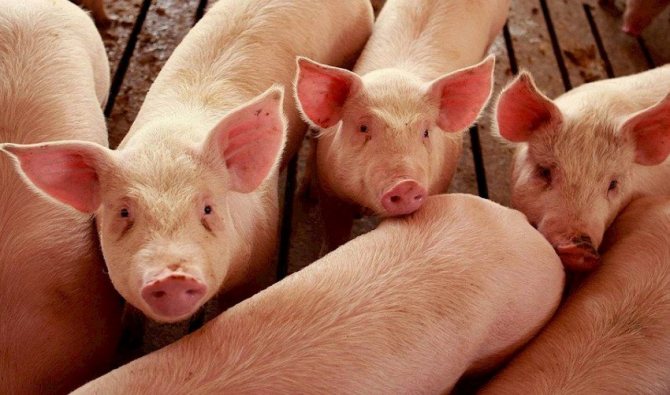

The daily ration for animals is presented:
- barley - 400 g;
- peas - 200 g;
- wheat bran - 400 g;
- cake - 150 g;
- potatoes - 1 kg;
- legumes - 2 kg;
- chalk - 25 g;
- salt - 30 g.
Bacon feed
Bacon feeding begins at the age of 2.5 months, before which the boars are castrated. At the same time, young animals should weigh 25 kg.
Important! 3 months before slaughter, products that adversely affect the quality of meat (soybeans, bran, fish waste) are excluded from the diet.
The daily ration for bacon feeding is presented:
- green food - 3 kg;
- backwards - 1.5 kg;
- concentrates - 1.5 kg;
- root crops - 2 kg;
- salt - 20 g.
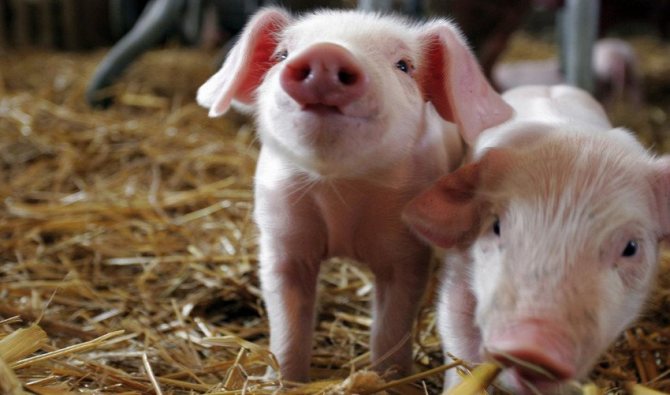

What and how to feed piglets?
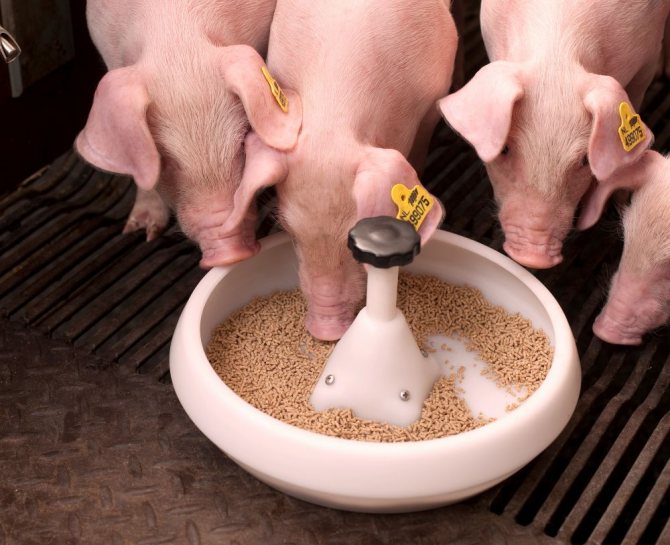

Each period of feeding piglets depends on the characteristics of the development and functioning of the digestive tract. When the sucking period ends, the stomach begins to produce hydrochloric acid, which allows you to expand the range of food products.
In general, the period up to 6 months is divided by:
- milk - up to 2 months;
- growing up - up to 4 months;
- fattening.
Milk period
Some feeds are taught to piglets from the moment their teeth begin to erupt (this happens on the fifth day from birth).
The diet gradually includes:
- toasted corn kernels;
- barley;
- peas;
- wheat.
If the sow's milk has disappeared, the animal is allowed to be transferred to cow. Used in reverse feeding: 100–150 g per day before weaning, and 700–1000 g after weaning.
Of the vitamin and mineral supplements, the following are useful:
- crushed feed chalk;
- charcoal;
- chopped beets, carrots;
- iron salts found in red clay;
- turf.


Suckers menu
From the second month in the diet there are cereals with milk, dairy products. The consistency of the feed is made mushy. Important! There should always be plenty of clean water in the drinker, change is made 6-8 times a day.
Supplementary feeding
By two months, piglets gain weight 16–20 kg, at four months - from 40 kg. At this age, the diet is replenished with a large number of products from the adult diet, but the changes are minor.
The task of the farmer during this period is to get more meat. On the first day after weaning, the indicated dosages are strictly observed in feeding, the food is divided into small portions.
Weaning diet:


In the first weeks, infusions of yarrow, wormwood are useful, which contribute to a better appetite. With a dry type of feeding, piglets receive feed ad libitum. In this case, it is especially necessary to provide them with access to clean water.
Maintaining the appetite of pigs
To maintain a good appetite for animals, you must:
- allocate more free space for walking;
- give enough salt daily;
- thermally process feed that is suitable for this (cooked food is eaten better);
- add soy milk to mash, which is less eaten than other types of food;
- add to food a small amount of apples, pears, plums, the taste of which is liked by animals.
The process of formulating a ration for pigs is not easy and depends on the age, weight and special periods of the animal's life. To make it easier to understand the nuances of feeding, you should carefully consider the above information and take it into account.
Prohibited foods for piglets
When planning a nutritious diet for young individuals, you need to understand that a number of foods should not be eaten. Piglets' health will be adversely affected by any feed that contains signs of rot, mold or parasites. Although pigs are considered to be omnivores to a certain extent, such feed worsens the condition of their body, especially at a young age.
Also, you should not eat a number of herbs from the green food category. Some plants contain substances that can cause severe poisoning. In particular, youngsters should avoid eating black nightshade, caustic buttercup, castor oil cake, pickleberry and horse dill. Sprouted potatoes and unripe tubers, in which there are large quantities of dangerous components indigestible by the pork body, must also be excluded from the diet.
Reception of newborn piglets
At birth, babies are still very weak and need increased attention around the clock. First of all, it is necessary to take care of the appropriate temperature regime so that the room is dry and there are no drafts. In the cold season, the piglets should be fenced off with a “kindergarten”, where, to reach the desired temperature (26-28˚C), hang an infrared lamp at a height of up to 50 cm and check t with a thermometer in the first few days.
Piglets are received in the following order:
- First of all, the baby is freed from the airway from the film, and then the whole body. Wipe the body dry with a dry, sterile diaper. At the same time, a light massage is done, and the pig begins to squeal - this is a good sign;
- The umbilical cord is cut or torn off at a distance of 3 cm from the body, after which the end is poured with iodine or brilliant green;
- If the piglet does not show signs of life, it is quickly cleared of mucus from its nose and mouth, patting on the sides, bending and unbending its limbs. Then it is immersed in hot water (40 41C), holding the head above the surface, for 3-5 minutes. When the piglet comes to its senses, it is wiped dry and placed with the rest of the piglets;
- For 15 minutes. placed in a box under a lamp to dry, and then placed under the sow, even if she is still in labor. Firstly, the pig becomes calmer when it feels the piglet, and secondly, the babies should receive colostrum in the first 2 hours of life. This is very important for piglets - with it they gain immunity and become more resilient.
Important! From the first days, accustom each piglet to its own teat - this will ensure uniform development and fast feeding, since the sow's milk flow is very short, up to 1 minute. The weaker ones are put on the nipples closest to the head - there is always more milk. If the strongest do not have enough food, they are taught to 2 teats.
Choosing a piglet for fattening
They are selected for fattening, piglets capable of rapid growth, healthy, of the appropriate breed. At the same time, it is necessary to take into account the financial side of the issue: it is cheaper to feed a pig during that period of the year when feed is more available.
Features of the
Breed - half-breeds are distinguished by the best vitality, enhanced growth and health - animals obtained by crossing a boar and sows of different breeds.
Time of birth - the cheapest food is grass and garden waste. Accordingly, it is most profitable to fatten the pig in the summer. To do this, take piglets from winter or early spring farrowing.
Feed - it is recommended to buy monthly piglets in order to accustom the animal to a variety of feeds from an early age. There are principles on how to feed correctly, 2-month-old piglets require less care, but they may already have stable eating habits, which is unprofitable.
Read the recipe for mixed feed for pigs with your own hands here.
Appearance - the exterior of a fattening animal is of great importance, since both the proportions of the body and the condition of the skin and bristles indicate the physical qualities of the animal. The following parameters are evaluated:
- the head is wide, medium in length, the eyes are set wide apart, the ears should not hang over the eyes. Thick ears are a disadvantage as they indicate rough skin. A short or pug-shaped head indicates effeminacy, a straight profile indicates late maturity, which is unprofitable;
- chest - wide and deep.But if the pig is raised for meat, individuals with a narrower breast are preferable;
- the neck is wide and short, and should blend imperceptibly into the body. Long neck indicates late maturity;
- the withers are wide, without depressions between the shoulder blades. The latter indicates the poor health of the animal;
- the back is broad, straight and long. The fastest growing pigs are those whose back and withers form one line;
- the sacrum should be wide and straight or slightly sloping. Loose, narrow, or too short indicates soreness;
- legs - straight, strong, set straight. This is especially important for meat breeds of pigs, which require a lot of movement;
- hams - developed and without interceptions. A thick tail indicates a rough body, drooping - on the general lethargy of the piglet and poorly developing muscle tissue;
- the skin should be tight, soft and not wrinkled, except for special breeds of pigs. The bristles should be soft, shiny and thick, bristling bristles indicate an inability to grow quickly.
Read about feed for fast growth of pigs here.
Standards for boars producers
As mentioned above, the rate depends on the sex of the animal in a particular group. Boars should be sexually active, which means they should not have depletion or excess fat. During the breeding season, producers need a large amount of nutritious feed. Along with the onset of the rest period, there is a decrease in the norm by 10 or 20% - this indicator depends on the weight of the animal.
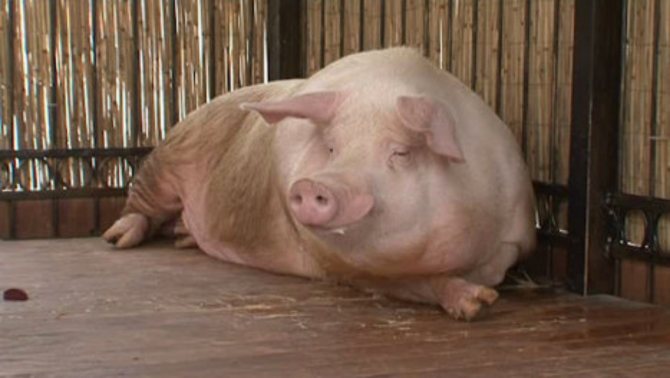

Feeding of sire boars
The following table will provide an example ration for a breeding boar weighing 250 kg during the breeding season.
| Name of feed | Rate per day in kg |
| Concentrated feed | 3,5 |
| Corn silage | 1 |
| Herbal flour | 0,5 |
| Fodder yeast | 0,2 |
| Minced fish | 0,5 |
| Milk replacer, return fresh | 2 |
| Feed chalk | 0,04 |
| Table salt | 0,02 |
Piglets from 2 weeks to 2 months
Gradually, water, minerals, fried crushed mixture, cereals and grated carrots are added to milk replacers.
It happens that it is necessary to take away the cubs from the mother when they are very young. In keeping and feeding piglets, you need to follow these rules:
- do not change the place where they were kept;
- do not allow drafts in the room.
Digestion of pups differs from adults in that they release gastric juice only after the body has received nutrition. But the juice does not yet contain hydrochloric acid, which kills bacteria and digests milk protein. Acid will only be produced at the age of 20 days, and the required concentration will become necessary by three months.
Therefore, it is important to reduce the amount of feed in the first days after weaning, then within 10 days the amount of food is brought to the previous level. If you overload the child's body, the pig may die.

